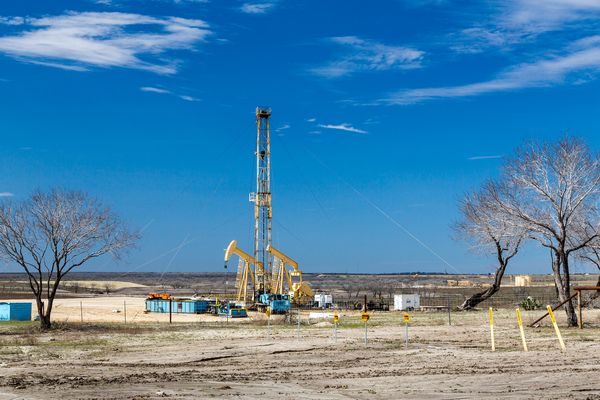http://news.nationalgeographic.com/news/energy/2013/11/131104-carbon-injection-earthquake-risks/
Photo of an oil well drilling rig near Peggy, Texas.

Oil rigs like this one long have been a feature of the Texas landscape. But for the first time, a study has traced a link between small earthquakes in western Texas and an increasingly common practice, underground injection of carbon dioxide to boost production.
Photograph by America, Alamy
Joe Eaton
For National Geographic
Published November 4, 2013
A cluster of 18 small earthquakes in western Texas was likely triggered by the injection of carbon dioxide into oil wells, according to a study published Monday in the scientific journal Proceedings of the National Academy of Sciences.
The study is the first to link carbon dioxide injections to actual earthquakes, and may help scientists evaluate the risks of storing greenhouse gas emissions deep underground, a fledgling technology for managing climate change known as geologic carbon sequestration. (See related “Quiz: What You Don’t Know About Carbon Capture.”) This week, energy secretaries from 22 nations and the European Union are meeting in Washington, D.C., to discuss how to spur global deployment of carbon capture and sequestration technologies.
The earthquakes evaluated in the study were magnitude 3 and slightly larger and occurred between 2006 and 2011 in the Cogdell oil field near Snyder, Texas. It was not the first time the area had experienced seismic activity. From 1975 to 1982, a number of earthquakes had struck the oil field. Scientists linked that seismic activity to the oil industry practice of injecting water into oil wells to increase production. When the water injections stopped, the earthquakes ceased.
Beginning in 2004, however, the oil industry injected carbon dioxide and other gases into wells in the Cogdell field, also in a bid to enhance production. Earthquakes returned soon after, according to the study.
Cliff Frohlich, study co-author and associate director of the Institute for Geophysics at the University of Texas at Austin, said carbon dioxide injection is the only variable that changed significantly before the earth started trembling.
Although injecting carbon dioxide to extract oil differs from carbon sequestration, Frohlich said his study could help scientists better understand possible risks of the technology, which has shown promise for reducing carbon emissions to the atmosphere.
“I’m not an expert on climate engineering, but a number of solutions have been proposed,” Frohlich said. “Whether they are good ideas or not, the jury is still out. Anytime you mess with the environment, there are unintended consequences.”
The study sheds further light on a category of seismic risks that is receiving increased attention in recent years: manmade risks caused by energy development that involves the injection of fluids underground, often at high pressure. The disposal of wastewater from hydraulic fracturing, or fracking, operations has been linked to temblors in several cases. (See related, “Fracking Wastewater Disposal Linked to Remotely Triggered Quakes” and “Scientists Say Oil Industry Likely Caused Largest Oklahoma Earthquake.”)
A 2012 report by the National Academy of Sciences warned that carbon sequestration might have the potential to induce larger earthquakes than fracking or injecting energy industry wastewater into the Earth’s subsurface. (See related blog post: “Tracing Links Between Fracking and Earthquakes.”) The increased risk is a result of the large volumes of carbon dioxide that would be injected, the study said. (See related, “Report Links Energy Activities to Higher Quake Risk.”)
Other scientists, however, worry the public might overlook the possible benefits of carbon sequestration by focusing on the risks. Andres Clarens, an assistant professor of environmental and water resources engineering at the University of Virginia, said he is concerned that Frohlich’s study could slow efforts to develop the technology. (See related, “Amid Economic Concerns, Carbon Capture Faces a Hazy Future,” and “A Quest to Clean Up Canada’s Oil Sands Carbon.”)
“Climate change is a well understood and imminent threat, and we are in dire need of strategies for reducing emissions while we scale up carbon-free energy sources,” Clarens said. “Quiz: What You Don’t Know About Climate Change Science.”)
In September, Clarens published a paper in Environmental Science and Technology, a scientific journal of the American Chemical Society, that proposed storing carbon dioxide in hydraulically fractured shale deposits after the removal of methane gas. The study found that the Marcellus shale formation in Pennsylvania alone has the potential to store roughly 50 percent of future U.S. nontransportation carbon dioxide emissions from 2018 to 2030.
Carbon sequestration is currently being tested at 65 sites around the world, including in Norway and Algeria and at a project site near Decatur, Illinois, where carbon dioxide totaling one million metric tons is being injected into a saline reservoir over a three-year period.
Wayne Pennington, a professor of geological and mining engineering and sciences at Michigan Technological University, said Frohlich’s paper is important because it provides the first example of an earthquake caused by carbon dioxide injection.
But Pennington said the study should not be read as the final word on the technology, which is widely used in international oil production without event.
What’s most intriguing, Pennington said, is that many locations are exposed to higher levels of injection than the Cogdell oil field but do not experience earthquakes. “We don’t know why,” he said. “Our understanding is clearly incomplete.” (See related, “Carbon Recycling: Mining the Air For Fuel,” and “Out of Thin Air: The Quest to Capture Carbon Dioxide.”)
This story is part of a special series that explores energy issues. For more, visitThe Great Energy Challenge.